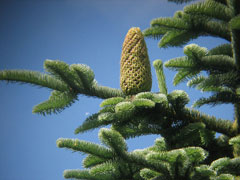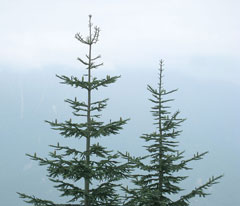 |
|
http://www.flickr.com/photos/brewbooks/ |
 |
| http://commons.wikimedia.org/wiki/User:Crusier |
Translate this page:
Summary
Form: Columnar, Pyramidal, Upright or erect.
Physical Characteristics

 Abies_procera is an evergreen Tree growing to 60 m (196ft) by 5 m (16ft) at a medium rate.
Abies_procera is an evergreen Tree growing to 60 m (196ft) by 5 m (16ft) at a medium rate.
See above for USDA hardiness. It is hardy to UK zone 5. It is in leaf all year, and the seeds ripen in September. The species is monoecious (individual flowers are either male or female, but both sexes can be found on the same plant) and is pollinated by Wind.
Suitable for: light (sandy), medium (loamy) and heavy (clay) soils and can grow in heavy clay and nutritionally poor soils. Suitable pH: mildly acid and neutral soils. It can grow in full shade (deep woodland) semi-shade (light woodland) or no shade. It prefers moist soil. The plant can tolerates strong winds but not maritime exposure.
UK Hardiness Map
US Hardiness Map
Synonyms
A. nobilis. Pinus nobilis.
Plant Habitats
Edible Uses
References More on Edible Uses
Medicinal Uses
Plants For A Future can not take any responsibility for any adverse effects from the use of plants. Always seek advice from a professional before using a plant medicinally.
A decoction of the leaves has been used as a cough medicine[257].
References More on Medicinal Uses
The Bookshop: Edible Plant Books
Our Latest books on Perennial Plants For Food Forests and Permaculture Gardens in paperback or digital formats.

Edible Tropical Plants
Food Forest Plants for Hotter Conditions: 250+ Plants For Tropical Food Forests & Permaculture Gardens.
More

Edible Temperate Plants
Plants for Your Food Forest: 500 Plants for Temperate Food Forests & Permaculture Gardens.
More

More Books
PFAF have eight books available in paperback and digital formats. Browse the shop for more information.
Shop Now
Other Uses
Wood - light, hard, strong, close grained, works easily. Used for lumber, interior work, pulp etc[46, 61, 82, 229].
Special Uses
References More on Other Uses
Cultivation details
Landscape Uses:Screen. Prefers a good moist but not water-logged soil[1]. Succeeds in cold exposed positions and in poor mountain peats[11]. Succeeds in poor thin soils so long as sufficient moisture is present[229]. Grows well in heavy clay soils. Plants are very shade tolerant, especially when young, but they grow more slowly in dense shade[81]. Intolerant of atmospheric pollution[1]. Prefers slightly acid conditions with a pH down to about 5[200]. Grows well on a north-facing slope[200]. A long-lived tree in the wild, with specimens more than 600 years old recorded[229]. It is a very ornamental tree[1], but is very susceptible to damage by aphis in some areas of the country[1, 11]. Planted for timber in W. and N. Europe[50], in Britain it grows best in wetter parts of the country such as the Perthshire valleys of Scotland[11]. Trees do not grow well in the drier areas of Britain[81]. In a suitable site it can make new growth of 1 metre a year until it is 25 metres tall when growth slows[185]. Exposure seems to severely limit growth in height in southern and eastern regions but less so in areas of high rainfall such as N. Wales and Argyll[185]. New growth takes place from early June to August[185]. Trees should be planted into their permanent positions when they are quite small, between 30 and 90cm in height. Larger trees will check badly and hardly put on any growth for several years. This also badly affects root development and wind resistance[200]. Trees are sometimes used as 'Christmas trees'[200]. Plants are strongly outbreeding, self-fertilized seed usually grows poorly[200]. They hybridize freely with other members of this genus[200]. Special Features:Attractive foliage, North American native, There are no flowers or blooms.
References Carbon Farming Information and Carbon Sequestration Information
Temperature Converter
Type a value in the Celsius field to convert the value to Fahrenheit:
Fahrenheit:
The PFAF Bookshop
Plants For A Future have a number of books available in paperback and digital form. Book titles include Edible Plants, Edible Perennials, Edible Trees,Edible Shrubs, Woodland Gardening, and Temperate Food Forest Plants. Our new book is Food Forest Plants For Hotter Conditions (Tropical and Sub-Tropical).
Shop Now
Plant Propagation
Seed - sow early February in a greenhouse or outdoors in March[78]. Germination is often poor, usually taking about 6 - 8 weeks[78]. Stratification is said to produce a more even germination so it is probably best to sow the seed in a cold frame as soon as it is ripe in the autumn[80, 113]. The seed remains viable for up to 5 years if it is well stored[113]. When large enough to handle, prick the seedlings out into individual pots and grow them on for at least their first winter in pots. Plant them out into their permanent positions in late spring or early summer, after the last expected frosts. Alternatively, if you have sufficient seed, it is possible to sow in an outdoor seedbed. One report says that it is best to grow the seedlings on in the shade at a density of about 550 plants per square metre[78] whilst another report says that they are best grown on in a sunny position[80].
Other Names
If available other names are mentioned here
Native Range
NORTHERN AMERICA: United States (Oregon (west), Washington (west), California (northwest))
Weed Potential
Right plant wrong place. We are currently updating this section.
Please note that a plant may be invasive in one area but may not in your area so it’s worth checking.
Conservation Status
IUCN Red List of Threatened Plants Status :

Growth: S = slow M = medium F = fast. Soil: L = light (sandy) M = medium H = heavy (clay). pH: A = acid N = neutral B = basic (alkaline). Shade: F = full shade S = semi-shade N = no shade. Moisture: D = dry M = Moist We = wet Wa = water.
Expert comment
Author
Rehder.
Botanical References
1160200
Links / References
For a list of references used on this page please go here
Readers comment
| Add a comment |
|
If you have important information about this plant that may help other users please add a comment or link below. Only comments or links that are felt to be directly relevant to a plant will be included. If you think a comment/link or information contained on this page is inaccurate or misleading we would welcome your feedback at [email protected]. If you have questions about a plant please use the Forum on this website as we do not have the resources to answer questions ourselves.
* Please note: the comments by website users are not necessarily those held by PFAF and may give misleading or inaccurate information.
To leave a comment please Register or login here All comments need to be approved so will not appear immediately.
|
|